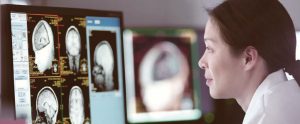Effective application of AI, big data, analytics, cloud computing, IoT, and mobile technology can make radical advances in patient care, staff productivity, and operational efficiency, explains Grant Thornton
Digital disruption has affected almost every industry across the globe, promising to create further dynamic impact as humans and machines navigate new ways of working. The healthcare industry is not immune to this disruption, in fact, it is experiencing a technological revolution, we are witnessing a shift from traditional to modern tech simulated healthcare, which will enable both medical professionals and patients to access new virtual resources, further aiding effectiveness and efficiency.
We are encountering emerging trends which will inevitably transform the industry, these range from digital behavioural health treatment, telehealth, the use of big-data, wearables and the important role which blockchain will play going forward.
Technology has largely existed within the healthcare industry for many years, particularly in the form of treatment tools and platforms which identify, diagnose and provide a remedy for various conditions, however the challenge which the industry faces today focuses on accepting, implementing and working alongside new and advanced technologies which will revolutionize the industry, whilst providing much needed personalization and connection for patients.
To further manifest this, we are witnessing a new wave of healthcare wearables, with shipments growing from 2.2 million units in 2016 to a projected 97.6 million in 2021, which will generate an estimated global revenue of $18 billion. Equally, these global trends resonate across the MENA region too. In the near future, individuals will be able to use wearables to measure and understand personal risk, whilst monitoring real-time results of making healthy choices.
Technology adoption
 With the high rate of technology adoption, the region could become global leaders in using wearable technology to transform personal healthcare, which is further supported by government targets which aims to increase the survival rate of sudden cardiac arrest from 5-10 per cent to 65 per cent by 2020, such targets will rely on smartphone apps which will notify nearby individuals with CPR training and alert emergency services alike.
With the high rate of technology adoption, the region could become global leaders in using wearable technology to transform personal healthcare, which is further supported by government targets which aims to increase the survival rate of sudden cardiac arrest from 5-10 per cent to 65 per cent by 2020, such targets will rely on smartphone apps which will notify nearby individuals with CPR training and alert emergency services alike.
Across the region, 2017 has seen a marked increase in the use of technology in healthcare industry, partly driven by the enforcement of mandatory health insurance across the GCC and the associated requirements by providers to digitally record and transmit patient information. Year 2018 will likely see continued investment in technology to streamline processes, promote transparency, improve diagnosis, build more efficient healthcare delivery methods, and to promote patient engagement to better self-manage their health conditions. Health technology is a broad field where innovation plays a crucial role in sustaining health, hence ongoing development of health-tech is fundamentally important. Tech-innovations are shaping the industry, and present lucrative opportunities for the MENA region. 3D printing in healthcare, for example, represents a rapidly growing field, it provides huge potential for the sector by allowing for cost effective production of customized medical devices and parts such as dental implants, prosthesis, tissue grafts, organ replicas, and prescription medicine.
In 2017, the region’s first-ever fully 3D-printed prosthetic leg was fitted to a Dubai resident. 3D printed prosthetics offer the same functionality of conventional prosthetics but at potentially half the cost, and can be produced faster, with more personalization in terms of both design and functionality. At a CAGR of 20 per cent, 3D printing in healthcare is expected to exceed $2.2 billion by 2024, and is just one example of how continuous advancement in technology is having a profound effect.
Cognitive and AI solutions
Meanwhile, Artificial Intelligence (AI) is already being used to correlate patient data, make diagnostic assessments, and for distance learning and training purposes. Global spend on cognitive and AI solutions is estimated to reach $46 billion by 2020. Year 2017 saw the opening of the UAE’s first smart pharmacies in Dubai, with the Dubai Hospital pharmacy featuring an AI robot that can dispense 12 prescriptions per minute. With its ability to substantially improve patient outcomes while potentially halving treatment costs. Adoption of AI technology within healthcare is rising, and the market is predicted to reach $7.98 billion by 2022 from $667 million in 2916, at a CAGR of 52.68 per cent between 2017 and 2022.
 Digital health takes AI one step further by integrating different technologies such as wearables, mobile wellness apps as well as telehealth and telemedicine, and including AI to reduce gaps in existing healthcare delivery and ensure early stage detection and initiation of preventative care. The region has some of highest rates of non-communicable diseases (NCDs) in the world including cardiovascular disease (CVD), obesity and diabetes, with the World Bank predicting that NCDs will account for 87 per cent of all deaths in the GCC by 2030, and 81 per cent in other MENA countries. The use of wearables helps encourage patients to measure and understand personal risk, whilst monitoring real-time results of making healthy choices.
Digital health takes AI one step further by integrating different technologies such as wearables, mobile wellness apps as well as telehealth and telemedicine, and including AI to reduce gaps in existing healthcare delivery and ensure early stage detection and initiation of preventative care. The region has some of highest rates of non-communicable diseases (NCDs) in the world including cardiovascular disease (CVD), obesity and diabetes, with the World Bank predicting that NCDs will account for 87 per cent of all deaths in the GCC by 2030, and 81 per cent in other MENA countries. The use of wearables helps encourage patients to measure and understand personal risk, whilst monitoring real-time results of making healthy choices.
Big data – Electronic Health Record systems
The advent of digital health and the IoT has led to unprecedented levels of patient health information and data. Big data in healthcare has wide-ranging and exciting implications as it can be used to discover trends and make predictions. One system to collect big data is the electronic health record (EHR) system. EHR systems are being widely adopted by providers as means of storing a patient’s entire medical history. The system allows doctors to improve diagnosis and increase rates of early detection, while the data amassed allows for a better understanding of overall population health, predict epidemics, & control disease.
EHR systems also enable real-time reporting which in turn leads to reduced waiting times and diminished costs. 2017 saw the successful implementation of Salama, the Dubai Health Authority’s (DHA) unified electronic medical record system, allowing easy access to electronic patient medical records across all DHA health facilities. More than 1.4 million DHA patient medical records and more than 112 million transactions have been transferred to the Salama system to date. The market for EHR is anticipated to witness steady growth and provide enormous potential rewards for vendors. Saudi Arabia, for example, is working towards integrating over 3,500 healthcare centres into a single EHR system by 2020.
Risks with data security
Patient information and data security go hand in hand, and with ever increasing amounts of data being collected, all players within the industry run the risk of being crippled by ransomware and other types of security risk. Blockchain offers the perfect solution: the technology enables the secure transfer and sharing of patient information between doctors and hospitals, while facilitating faster medical insurance claims, and better equipping nations to manage a health crisis such as a disease outbreak. The UAE is leading regional innovation in blockchain technology with its strategy to secure all government records on blockchain by 2020.
The MENA region’s unique demographics have spurred robust growth in the healthcare sector: home to over 160 million people, of which 85 million are online, with access to high disposable income and spending power, it is also home to an increasing number of NCDs – of which CVDs are the single largest killer. Likewise, the prevalence of diabetes and obesity is amongst the highest in the world. The region also has an ageing population estimated at 20 per cent by 2050, compared to 2 per cent today, which according to trends will influence an increased need for high quality, cost effective, and efficient healthcare in the future.
We have a real opportunity to improve patients’ lives in the region by moving from reactive to proactive and preventative care. The effective application of AI, big data, analytics, cloud computing, IoT, and mobile technology can make radical advances in patient care, staff productivity, and operational efficiency. By leveraging technology, the region can drive effective and sustainable change to this ever-developing and increasingly prominent industry, and more importantly, reduce the incidence of NCDs and significantly improve the health of its citizens.
CREDITS: This article is extracted from “Health-Tech – an underserved industry” (www.grantthornton.ae/ insights/articles/health-tech) by Grant Thornton – a world leading organization of independent assurance, tax and advisory firms with over 47,000 people across 130+ countries.














